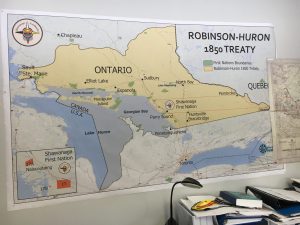
“You follow this and keep fighting for this.”
That’s what Chief Wayne Pamajewan of Shawanaga First Nation was told by elders about the Robinson-Huron Treaty when he first got involved in his community in 1973. He says the Treaty would become his “bible.”
Twenty-one First Nations in northern Ontario have won a court case against the federal and provincial governments to increase their yearly annuities, which have not been raised in over 140 years. Since 1874, beneficiaries of the Robinson-Huron Treaty have been collecting $4 each per year. That includes Henvey Inlet, Wausauksing, Magnetawan and Shawanaga First Nations.
“We want the courts to recognize that there is a commitment and a bottom line made back in 1874, prior to 1874, we received $2. The annuities themselves would be adjusted according to what is brought out of the land and resources. The benefits of that will come directly to us,” the chief said.
After 30 years, Pamajewan has returned as chief and saw an opportunity to push for the Treaty to be recognised by the province.
“Our leaders wanted to ensure that the future generations of our people will benefit from the lands they have identified as treaty territory. 36,000 square miles were identified. In that, the government of the time said that our people would benefit from the resources of those particular lands, that means renewable and non-renewable resources anything that came out of those lands that generated revenue would be shared with us.”
Pamajewan says he has a team of researchers and analysts combing through records and government documents though Pamajewan isn’t confident that he will be able to gather all of the necessary information needed from government departments.
“This is about honesty… There were promises made and a commitment made. That commitment now has been legalized and has been identified by the court. This signifies to us that there is a legal obligation for (the federal government) to sit down with us and examine what is owed. We aren’t sure what the number is yet but it’s a heck of a lot better than four bucks,” he said.
Resources in question include forestry and timber, mining and aggregates, and renewable resources such as hunting and conservation.
“If the annuity had been done properly and we saw the benefits of that, the majority of my people wouldn’t be living the way they are today. Living conditions on the First Nations, because of the limited resources that we have, has really impaired our people. We’ve had various sicknesses because of the lack of resources. We can’t provide and the government doesn’t provide…yet. They were holding on to this document knowing full-well that the benefits were there. Somebody has to take that torch and keep going,” the Chief said.
In 2013, Pamajewan said that he met with mayors from local municipalities to ensure that they were made aware of the Treaty land agreement and the obligations to consult and inform First Nations chiefs about developments in council chambers relating to land use. He also met with former premier Kathleen Wynne to discuss the education of Canadians, from children to bureaucrats and he says she agreed with his point that most government-funded public education inaccurately depicts history in relation to First Nations treaties and matter-of-fact events.
Pamajewan says that the funds owed shouldn’t necessarily come from tax paying citizens but from government bodies that have been generating revenue in other ways.
While there is no clear number of what is owed to First Nations people, Pamajewan says he is looking forward to his people receiving benefits within the next few years. The Robinson-Huron Treaty has been acknowledged as legally binding in court on December 21st. Judge Patricia Hennessey ruled both governments should have regularly increased the annuity based on the terms of the Robinson-Huron Treaty.
The Chief said that having the Treaty and acknowledgement of annuities owed was the hard part though expects to discuss the statute of limitations in September and eventually, come to a quantification of the amount of money that is outstanding.


